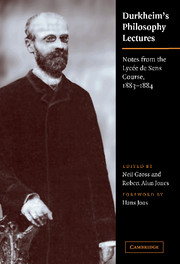Book contents
- Frontmatter
- Contents
- Foreword
- Translators' Note
- Acknowledgments
- Introduction
- Part I Preliminary Matters
- Part II Psychology
- Part III Logic
- 38 Introduction. On Logic
- 39 On Truth. On Certainty
- 40 On Certainty (Conclusion)
- 41 On False Certainty or Error
- 42 Skepticism
- 43 Ideas. Terms. Judgments. Propositions
- 44 Definition
- 45 On the Syllogism
- 46 On Induction
- 47 Fallacies
- 48 On Method
- 49 Method in the Mathematical Sciences
- 50 The Methodology of the Physical Sciences
- 51 Method in the Natural Sciences
- 52 Method in the Moral Sciences
- 53 Method in the Historical Sciences
- 54 Language
- Part IV Ethics
- Part V Metaphysics
- Appendix: Biographical Glossary
- Index
51 - Method in the Natural Sciences
Published online by Cambridge University Press: 21 October 2009
- Frontmatter
- Contents
- Foreword
- Translators' Note
- Acknowledgments
- Introduction
- Part I Preliminary Matters
- Part II Psychology
- Part III Logic
- 38 Introduction. On Logic
- 39 On Truth. On Certainty
- 40 On Certainty (Conclusion)
- 41 On False Certainty or Error
- 42 Skepticism
- 43 Ideas. Terms. Judgments. Propositions
- 44 Definition
- 45 On the Syllogism
- 46 On Induction
- 47 Fallacies
- 48 On Method
- 49 Method in the Mathematical Sciences
- 50 The Methodology of the Physical Sciences
- 51 Method in the Natural Sciences
- 52 Method in the Moral Sciences
- 53 Method in the Historical Sciences
- 54 Language
- Part IV Ethics
- Part V Metaphysics
- Appendix: Biographical Glossary
- Index
Summary
The term “natural sciences” is quite vague and is often used to refer to things as different as natural history and physiology. So it's important to begin by determining its exact meaning. We'll use it to describe those “sciences” that don't rely on experimentation – especially natural history.
As we just argued, sciences of this kind don't establish laws but merely ascertain facts. Since it's impossible to study facts without putting them in some kind of order or imposing some kind of limit on them (the mind can't do so, and – if it could – wouldn't find any satisfaction in it), the essential procedure of these sciences is to place facts in some sort of classification.
Classification serves two ends:
It aids memory. The number of natural phenomena is infinite, and even the best of memories can't retain them all. Classification facilitates the study of such phenomena by placing them in order, enabling us to recall facts more easily and to recognize them more readily than when they simply appear in nature.
Classification allows us to see nature's design. Nature has a certain plan, a certain way of classifying things, and because it's gratifying to recover this plan, the natural sciences satisfy us.
What exactly is classification? It's the operation by which we arrange observed beings or facts into distinct, hierarchically organized groups. Classifications can be artificial or natural.
Artificial classifications arrange facts or beings according to certain external characteristics.
- Type
- Chapter
- Information
- Durkheim's Philosophy LecturesNotes from the Lycée de Sens Course, 1883–1884, pp. 213 - 214Publisher: Cambridge University PressPrint publication year: 2004



